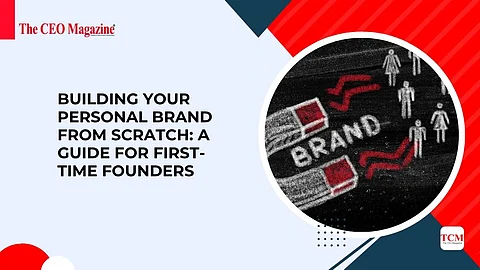
- News
- Women
- Magazine
- IndustryIndustry
- InsightsInsights
- Success Stories
- PublishPublish
- ContactContact
- Media KitMedia Kit

Building Your Personal Brand
Let me ask you something straight up:
If you disappeared from the internet tomorrow, would anyone notice?
As a first-time founder, you're not just building a product or a startup—you’re building trust, influence, and visibility. And it all begins with one thing: your personal brand.
You might be thinking:
“I don’t have a big following. I’m not a LinkedIn influencer. Why would anyone care about my brand?”
Here’s the secret...
People don’t invest in ideas. They invest in the people behind them.
Whether it’s attracting co-founders, hiring top talent, convincing early investors, or winning customers—your personal brand is your biggest unfair advantage.
And if you’re starting from scratch, don’t worry.
So did every founder you admire today.
Let me walk you through exactly how to build your personal brand from zero—even if no one knows you yet.
We live in an era of founder-led brands. Think about it:
Elon Musk and Tesla.
Deepinder Goyal and Zomato.
Falguni Nayar and Nykaa.
These founders are the brand. Their stories, values, and voices humanise the company, attract followers, and build trust.
“Your personal brand is what people say about you when you're not in the room.”
– Jeff Bezos
As a founder, your online presence is your digital handshake.
And trust me, investors, journalists, and potential hires Google you before they meet you.
Before you post anything, ask yourself:
“What do I want to be known for?”
This isn’t about pretending to be someone else. It’s about becoming crystal clear on your values, strengths, and the problem you’re obsessed with solving.
Why did you start your venture?
What makes your perspective unique?
What values guide your decisions?
In my experience, the most compelling founder brands are rooted in purpose.
They don’t try to be everything to everyone. They stay consistent, authentic, and focused.
Example:
Kunal Shah of CRED built his personal brand around sharp insights on consumer behaviour, economics, and startups. He didn’t chase trends—he owned a niche.
You don’t need to be everywhere. In fact, starting with one or two platforms is smarter.
LinkedIn: Ideal for B2B founders, investors, and professional storytelling.
Twitter (X): Great for quick insights, conversations, and building a tech/startup community.
Instagram/Reels/YouTube: Visual storytelling and behind-the-scenes content work well here.
Medium/Substack: For long-form thought leadership.
If you're just starting out, LinkedIn is non-negotiable.
It has the highest organic reach for founders right now.
Let’s talk basics.
Before anyone reads your content, they’ll judge your profile picture, bio, and the first 3 lines of your intro.
Professional, high-resolution photo: Smile. No cropped party pics.
Compelling bio: Who you are, what you do, and why it matters. Keep it human.
Link to your startup: With a strong one-liner. E.g. "Empowering small businesses to accept digital payments effortlessly."
Make sure your personal brand aligns with your startup brand. Consistency builds trust.
Here’s what most first-time founders get wrong:
They jump straight into pitching their product or startup. But people don’t connect with features—they connect with founders.
Why you started your journey.
The biggest challenges you’re facing.
Lessons learned from building.
Your perspective on industry trends.
Let your story unfold.
Imagine you're documenting the “founder’s journey” in real time. That’s gold.
Pro Tip:
People love honesty. One of my most viral posts started with:
“We had only ₹2,000 left in the bank. And then…”
You don’t need to go viral. You need to be valuable and consistent.
Founder insights (lessons from building)
Industry commentary (what’s happening and why it matters)
Vulnerable stories (mistakes, pivots, wins)
Bite-sized learnings (what your audience can use)
Use simple language. Add a personal touch. And always end with a call-to-action like:
“What do you think?”
“Have you faced this too?”
“Would love your feedback on this approach.”
Think of social media as a networking room, not a stage.
Don’t just shout. Converse.
Comment on posts from other founders or investors.
Share other people’s content with your insights.
Reply to comments on your posts within 24 hours.
Join startup communities like Product Hunt, Indie Hackers, and Twitter threads.
“The best way to grow your personal brand is to contribute to others’ brands first.”
When people see your name show up consistently with value, they start to trust you—even before they follow you.
Your personal brand isn’t just for likes. It’s a growth asset.
Investors already know you before the pitch.
Top talent reaches out to you instead of the other way around.
Customers feel connected to your mission, not just your product.
Journalists find your story worth telling.
In fact, most of the founders I work with say their personal brand becomes their top inbound channel over time.
You don’t need to be a unicorn founder to be worth following.
You just need to be honest, helpful, and human.
Imagine this:
Day 1: “We’re launching our MVP today. Excited and nervous.”
Day 30: “We got our first paying customer!”
Day 90: “We hit ₹1 lakh MRR—here’s how we did it.”
That kind of storytelling?
People follow it. People root for it. People share it.
Finally, let me say this:
Your personal brand is a marathon, not a reel challenge.
Take breaks. Repurpose content. Set boundaries.
If it ever feels overwhelming, go back to the basics:
“What do I want to be known for?”
“Who am I trying to help today?”
If you’ve read this far, here’s what I want you to remember:
You don’t need a million followers.
You don’t need perfect content.
You do need clarity, consistency, and courage.
Start showing up. Start sharing your story. Start building your personal brand—brick by brick, post by post.
Because the world doesn’t just need another product.
It needs a founder with a voice, a mission, and a message.
Follow us on Google News
